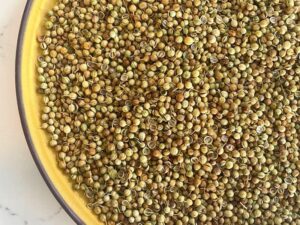A Guide To Buying & Using Mustard Seeds

Without mustard seeds, an Indian dish is incomplete. These minute seeds are one of the must-have ingredients when tempering spices. Mustard seeds have become popular globally and they are used to prepare many types of condiments as well as oil.
People often purchase bulk mustard seeds to have a regular supply of spice. In case you have never been to the use of these seeds, no problem. Here is how to get and utilize mustard seeds.
What are mustard seeds?
Black, brown, and white mustard seeds all come from different plants; namely, a mustard plant indigenous to North Africa, Europe as well as Eurasia.
Black mustard seeds come from the Brassica Nigra plant. This variety is more prevalent in the Middle East and Asia Minor, where they originated. Black mustard seeds are tiny and compact. The seeds can be ground to make a spice or heated in the oil to bring the flavors out.
Brassica Juncea plant produces brown mustard seeds. This variety of mustard seeds is also often called Chinese or Indian. Brown mustard seeds have different types of mustard seeds, ranging from those with dark brown seed coating to dark yellow.
Yellow mustard is prepared from a white mustard seed, whereas it converts to a yellow color after being given a coloring matter or turmeric. White Mustard seeds are derived from the Sinapis alba plant which is in the Brassicaceae family though not closely related to the other species. White Mustard seeds have a slight tan shade and are also bigger than brown or black ones.
The origin of mustard seeds
Wild mustard plants grow everywhere in the world. It is unknown when the mustard seeds were domesticated. The seeds have been a documented food as its mention comes in 206 BC records where they were eaten by the Han dynasty of China. This spice also has been mentioned in the Bible.
But its usage dates back to the ancient Roman and Egyptian eras. Romans are believed to have brought mustard seeds from Egypt. And from there, mustards spread across Europe. The brown mustard variety is native to China and was introduced to India. It grows in the Himalayan regions.
What do mustard seeds taste like?
Black mustard seeds are the most intense among the three varieties and are also the least common. They have a strong, spicy, and bitter taste with nutty notes. The closest resemblance of the taste is like horseradish or wasabi seeds. Whole seeds do not have that strong flavor.
It can only be tasted when bitten or ground into powder. Brown mustard seeds are less intense than their black counterpart and often mixed with them to lower the spice. Similarly, yellow mustard seeds are lower in pungency than black and brown seeds. The yellow variety is often used to create mustard, a popular condiment in Europe and America.
Cooking with mustard seeds
Mustard seeds, also known as black mustard seeds or brown mustard seeds, are a common ingredient in Indian cuisine. These seeds are cooked in a pan and then fried in oil to crackle. Tadka or tempering is the process by which the seed is broken open and the flavor is brought to the surface. It is usually done at the start or the end of the cooking time.
You can also toast the white mustard seeds for pickling, or add them to your meals. These mustard seeds may also be used for making mustard. In addition, mustard seed is also used for the production of mustard oil in the countries of South Asia and Southeast Asia.
Where to purchase mustard seeds from
Mustard seeds are easily available in supermarkets and spice stores. If you have an Indian specialty cuisine store nearby, you can also purchase them from there. However, the best way to find high-quality mustard seeds is by purchasing from stores that frequently restock their shelves.
This is because mustards have a short shelf life like any other spice. And buying stale spice or one that is nearing the expiry date would not give you as much flavor as the fresh spice. If you want to purchase bulk mustard seeds, you can use any Indian spices exporter. You can also find them online or from local distributors.
How to store mustard seeds
Storing mustard seeds requires some care. They have volatile air, which provides flavor to the spice. And if not stored properly, these oils evaporate quickly, resulting in stale spice. Though consuming them does not affect our health, you might have to use them more than you usually do to achieve that characteristic flavor.
Therefore, store mustard seeds in an airtight container so air can’t seep in and speed up evaporation. Also, place the seed where heat or light comes in lower amounts. They can also encourage oxidation and evaporate volatile oils.
Conclusion
Mustard seeds are an important part of many cuisines around the world. They are warm and spicy and infuse a nutty flavor with our food. But for people who have never used mustard seeds, cooking and storing them could be confusing.
That is why this blog has discussed how to store and use mustard seeds and other spice information.






